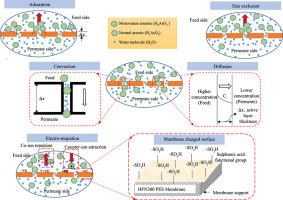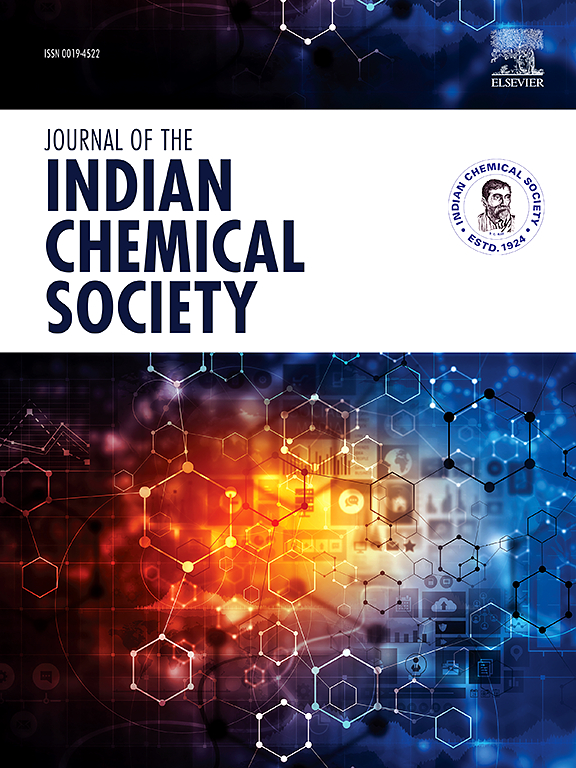Techno-economic analysis of arsenic (III) removal using spiral wound polyethersulfone nanofiltration membrane at pilot scale
IF 3.2
4区 化学
Q2 CHEMISTRY, MULTIDISCIPLINARY
引用次数: 0
Abstract
In this work, the influence of initial solution pH on membrane performance was carried out for arsenic (III) removal using spiral wound polyethersulfone (HFN300) Nanofiltration membrane at pilot scale. The rejection percentage was found to increase from 49 % to 96 % while increasing initial solution pH from 4 to 10. Speciation of arsenic, solute-membrane affinity, electric-migration effect along with convection and diffusion were found to be dominant mechanisms for arsenic removal. Donnan Steric Pore Model was selected to estimate the membrane parameters including pore radius (0.313 nm), membrane thickness (2.17 μm), and membrane charge density (−3.56 mol/m3).Excellent agreements were found between the experimental and simulated values for all the studied pH range. Selected model works satisfactorily within 10 % of error for both rejection percentage and permeate flow. Economic feasibility study was carried out for the rural population (India) and total annualized cost was found to be USD 0.90/m3 that seems both reasonable and affordable for arsenic free drinking water. It can be concluded that annualized production cost was dependent on membrane lifespan, electricity tariff, per capita, population size, arsenic feed concentration, etc. The result obtained in the study suggests the feasibility of using the NF process in removing arsenic from contaminated water. Overall, the study provides valuable insights into the mechanisms governing arsenic (III) removal through nanofiltration process using spiral wound polyethersulfone nanofiltration membrane at pilot scale, demonstrating the effectiveness of pH optimization and membrane modelling in improving removal efficiency, which can contribute to the development of cost-effective solutions for safe drinking water in arsenic-affected rural areas.

利用螺旋缠绕聚醚砜纳滤膜在中试规模上去除砷 (III) 的技术经济分析
在这项工作中,使用螺旋缠绕聚醚砜(HFN300)纳滤膜进行了中试,研究了初始溶液 pH 值对膜性能的影响,以去除砷(III)。结果发现,当初始溶液 pH 值从 4 升至 10 时,去除率从 49% 上升至 96%。研究发现,砷的种类、溶质与膜的亲和力、电迁移效应以及对流和扩散是砷去除的主要机制。在所有研究的 pH 值范围内,实验值和模拟值都非常吻合。在所有研究的 pH 值范围内,实验值和模拟值都非常吻合。所选模型在排斥率和渗透流量方面的误差都在 10% 以内,效果令人满意。针对农村人口(印度)进行了经济可行性研究,发现年化总成本为 0.90 美元/立方米,这对于无砷饮用水来说似乎既合理又负担得起。可以得出的结论是,年化生产成本取决于膜寿命、电费、人均、人口数量、砷原料浓度等。研究结果表明,使用纳滤工艺去除受污染水中的砷是可行的。总之,该研究为在中试规模上使用螺旋缠绕聚醚砜纳滤膜通过纳滤工艺去除砷(III)的机制提供了宝贵的见解,证明了 pH 值优化和膜建模在提高去除效率方面的有效性,有助于为受砷影响的农村地区开发具有成本效益的安全饮用水解决方案。
本文章由计算机程序翻译,如有差异,请以英文原文为准。
求助全文
约1分钟内获得全文
求助全文
来源期刊
CiteScore
3.50
自引率
7.70%
发文量
492
审稿时长
3-8 weeks
期刊介绍:
The Journal of the Indian Chemical Society publishes original, fundamental, theorical, experimental research work of highest quality in all areas of chemistry, biochemistry, medicinal chemistry, electrochemistry, agrochemistry, chemical engineering and technology, food chemistry, environmental chemistry, etc.

 求助内容:
求助内容: 应助结果提醒方式:
应助结果提醒方式:


